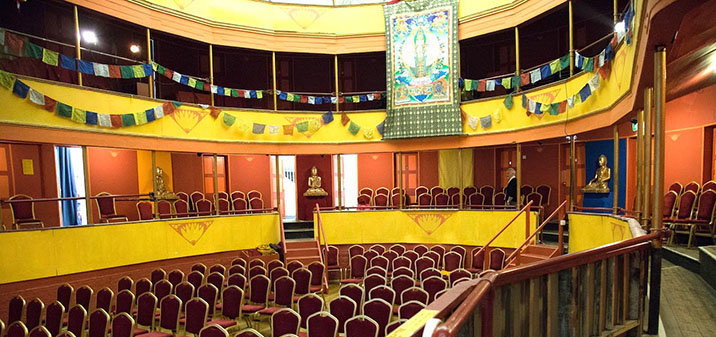Take a look inside this unassuming building on Newmarket Road
A neat, white, terraced building, Cambridge Buddhist Centre is easy to miss as you scurry along Newmarket Road – but its unassuming exterior belies a fascinating history. The building is formed partly of a renovated Georgian house and partly of the Barnwell Festival Theatre, which dates back to 1814 and is regarded as being one of the most historically important buildings in Cambridge.
It’s one of only a handful of pre-Victorian theatres outside London, and once formed part of the Norwich Circuit – a group of performance venues built for touring company the Norwich Players, who were regulars at local events including Stourbridge Fair.
In 1849 the theatre was renamed as the Theatre Royal Barnwell, and for a period it thrived as one of the major provincial theatres, welcoming celebrities of the day including Charles Dickens, who gave readings there. Although initially very successful, the theatre’s fortunes changed, leading to financial struggles. It was auctioned in 1878 to a Mr Robert Sayle – the owner of the store which became John Lewis – and turned into a mission hall. A spell as a boys’ club for King’s College followed, and a period of dereliction, until the theatre was bought in 1926 by millionaire racehorse owner Terence Gray, also the proprietor of Gog Magog Hills.
He turned it into a cutting-edge theatre, using abstract forms and lighting effects. Among the innovations he oversaw was a cyclorama, which stood at 40ft high and was constructed of two layers of hollow tiles surfaced with a special cement to resist indentation and preserve a smooth surface. The flat surface, flooded evenly with light, almost defied detection and gave an amazing effect of distance. It was a huge hit for seven or so years, attracting famous names including WB Yeats and Ninette de Valois, before being picked up by a commercial management company and gradually declining until it closed in 1939. It’s theatrical life wasn’t quite over though; it would be briefly resurrected during World War II as a place for The Cam Merrymakers to entertain troops. After the war it became a wardrobe workshop for the Arts Theatre, surviving almost untouched while a massive redevelopment went on around it to form the Grafton Centre. Its final performance was The Seagull in October 1997, before it was brought the following year by the Windhorse Trust to become the new Cambridge Buddhist Centre. Many original theatre features are fully intact today, which you can see for yourself at Open Cambridge this month.

